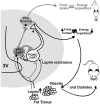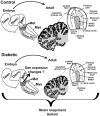Maternal Diabetes and Fetal Programming Toward Neurological Diseases: Beyond Neural Tube Defects
- PMID: 30483218
- PMCID: PMC6243582
- DOI: 10.3389/fendo.2018.00664
Maternal Diabetes and Fetal Programming Toward Neurological Diseases: Beyond Neural Tube Defects
Abstract
The purpose of this review was to search for experimental or clinical evidence on the effect of hyperglycemia in fetal programming to neurological diseases, excluding evident neural tube defects. The lack of timely diagnosis and the inadequate control of diabetes during pregnancy have been related with postnatal obesity, low intellectual and verbal coefficients, language and motor deficits, attention deficit with hyperactivity, problems in psychosocial development, and an increased predisposition to autism and schizophrenia. It has been proposed that several childhood or adulthood diseases have their origin during fetal development through a phenomenon called fetal programming. However, not all the relationships between the outcomes mentioned above and diabetes during gestation are clear, well-studied, or have been related to fetal programming. To understand this relationship, it is imperative to understand how developmental processes take place in health, in order to understand how the functional cytoarchitecture of the central nervous system takes place; to identify changes prompted by hyperglycemia, and to correlate them with the above postnatal impaired functions. Although changes in the establishment of patterns during central nervous system fetal development are related to a wide variety of neurological pathologies, the mechanism by which several maternal conditions promote fetal alterations that contribute to impaired neural development with postnatal consequences are not clear. Animal models have been extremely useful in studying the effect of maternal pathologies on embryo and fetal development, since obtaining central nervous system tissue in humans with normal appearance during fetal development is an important limitation. This review explores the state of the art on this topic, to help establish the way forward in the study of fetal programming under hyperglycemia and its impact on neurological and psychiatric disorders.
Keywords: diabetes; fetal programming; neurological disorders; pregnancy; psychiatric disease.
Figures



Similar articles
-
Effect of maternal diabetes on the embryo, fetus, and children: congenital anomalies, genetic and epigenetic changes and developmental outcomes.Birth Defects Res C Embryo Today. 2015 Mar;105(1):53-72. doi: 10.1002/bdrc.21090. Epub 2015 Mar 16. Birth Defects Res C Embryo Today. 2015. PMID: 25783684 Review.
-
Experimental models of developmental programming: consequences of exposure to an energy rich diet during development.J Physiol. 2005 May 15;565(Pt 1):3-8. doi: 10.1113/jphysiol.2004.079756. Epub 2005 Feb 3. J Physiol. 2005. PMID: 15695245 Free PMC article. Review.
-
Chapter 30: historical aspects of the major neurological vitamin deficiency disorders: the water-soluble B vitamins.Handb Clin Neurol. 2010;95:445-76. doi: 10.1016/S0072-9752(08)02130-1. Handb Clin Neurol. 2010. PMID: 19892133 Review.
-
The Fascinating and Complex Role of the Placenta in Pregnancy and Fetal Well-being.J Midwifery Womens Health. 2015 Jul-Aug;60(4):360-70. doi: 10.1111/jmwh.12344. J Midwifery Womens Health. 2015. PMID: 26255798 Review.
-
[Programming nutritional and metabolic disorders: the diabetic environment during gestation].Arch Pediatr. 2010 Jan;17(1):60-70. doi: 10.1016/j.arcped.2009.10.014. Epub 2009 Nov 25. Arch Pediatr. 2010. PMID: 19942417 French.
Cited by
-
Mitochondria in Early Forebrain Development: From Neurulation to Mid-Corticogenesis.Front Cell Dev Biol. 2021 Nov 23;9:780207. doi: 10.3389/fcell.2021.780207. eCollection 2021. Front Cell Dev Biol. 2021. PMID: 34888312 Free PMC article. Review.
-
The early life exposome and autism risk: a role for the maternal microbiome?Gut Microbes. 2024 Jan-Dec;16(1):2385117. doi: 10.1080/19490976.2024.2385117. Epub 2024 Aug 9. Gut Microbes. 2024. PMID: 39120056 Free PMC article. Review.
-
Stem cell fate determination through protein O-GlcNAcylation.J Biol Chem. 2021 Jan-Jun;296:100035. doi: 10.1074/jbc.REV120.014915. Epub 2020 Dec 1. J Biol Chem. 2021. PMID: 33154167 Free PMC article. Review.
-
Long-term effects of gestational diabetes mellitus on the pancreas of female mouse offspring.World J Diabetes. 2024 Apr 15;15(4):758-768. doi: 10.4239/wjd.v15.i4.758. World J Diabetes. 2024. PMID: 38680692 Free PMC article.
-
Genetic and epigenetic alterations associated with gestational diabetes mellitus and adverse neonatal outcomes.World J Clin Pediatr. 2025 Mar 9;14(1):99231. doi: 10.5409/wjcp.v14.i1.99231. eCollection 2025 Mar 9. World J Clin Pediatr. 2025. PMID: 40059904 Free PMC article. Review.
References
-
- Reyes-Munoz E, Castellanos-Barroso G, Ramirez-Eugenio BY, Ortega-Gonzalez C, Parra A, Castillo-Mora A, et al. . The risk of gestational diabetes mellitus among Mexican women with a history of infertility and polycystic ovary syndrome. Fertil Steril. (2012) 97:1467–71. 10.1016/j.fertnstert.2012.03.023 - DOI - PubMed
-
- Reyes-Munoz E, Parra A, Castillo-Mora A, Ortega-Gonzalez C. Effect of the diagnostic criteria of the International Association of Diabetes and Pregnancy Study Groups on the prevalence of gestational diabetes mellitus in urban Mexican women: a cross-sectional study. Endocr Pract. (2012) 18:146–51. 10.4158/EP11167.OR - DOI - PubMed
-
- Lamadrid-Romero M, Solis KH, Cruz-Resendiz MS, Perez JE, Diaz NF, Flores-Herrera H, et al. . Central nervous system development-related microRNAs levels increase in the serum of gestational diabetic women during the first trimester of pregnancy. Neurosci Res. (2017) 130:8–22. 10.1016/j.neures.2017.08.003 - DOI - PubMed
Publication types
LinkOut - more resources
Full Text Sources
Molecular Biology Databases

